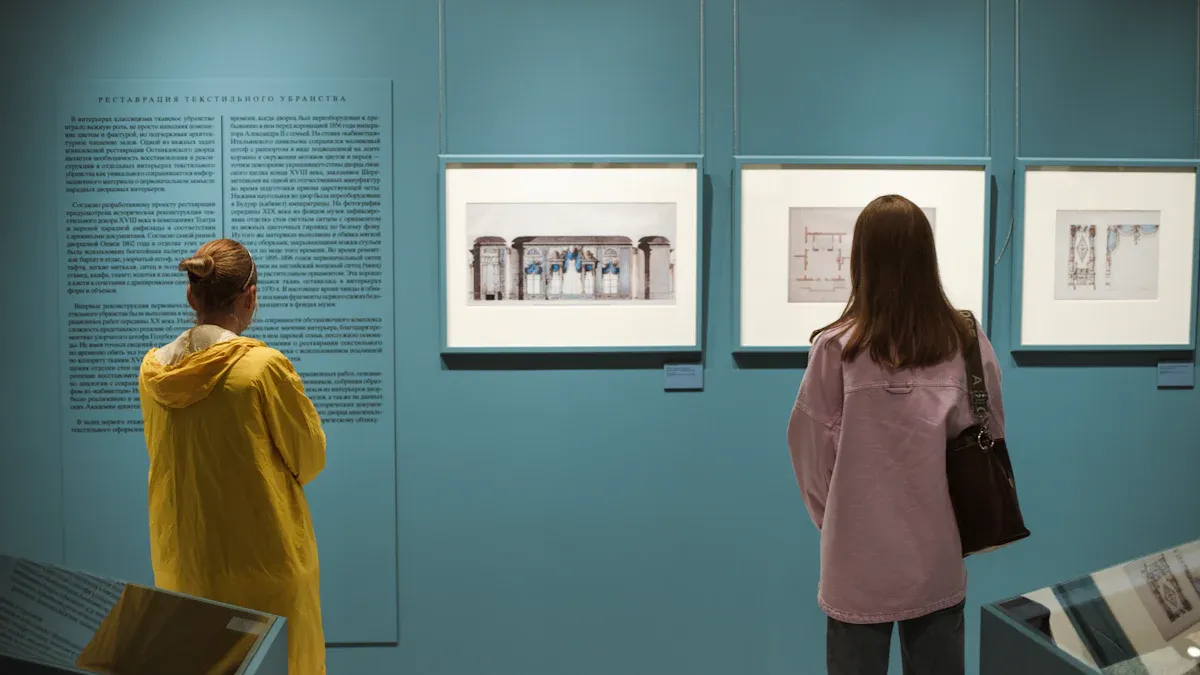Innovative materials offer a powerful solution for this challenge. Recyclable acrylic options help institutions meet new expectations from visitors and funders. This article serves as a guide for museum leaders. It shows how to leverage this material for strategic gains in 2025.
Meeting sustainability mandates
Museums today operate in an environment where sustainability is a core expectation. Funders, visitors, and communities demand that institutions demonstrate environmental responsibility. This shift is part of a larger global trend. By 2025, an estimated 65% of major brands will use sustainable materials in their operations. Museums are a vital part of this crucial movement, and recyclable acrylic provides a clear path forward.
Securing grants and funding
Financial supporters and grant-making bodies increasingly require proof of sustainable practices. They want to see measurable data in Environmental, Social, and Governance (ESG) reports. This is where material choice becomes critical. Using recycled cast acrylic (rMMA) gives museum leaders the concrete data they need. It shows a clear commitment to green initiatives, strengthening applications for environmental grants and other funding opportunities. This choice proves that the museum's mission extends to protecting the planet.
Reducing carbon footprint
Choosing sustainable materials delivers a significant and quantifiable environmental impact. The data on recycled acrylic is compelling. It offers a powerful way for museums to lower their carbon emissions and contribute to a healthier environment.
📉 Did You Know? Using 100% recycled acrylic can reduce CO2 emissions by up to 90% compared to producing new, virgin acrylic.
This dramatic reduction helps museums achieve internal sustainability goals. It also sends a powerful message to the public. By specifying recycled acrylic for vitrines, displays, and retail fixtures, a museum actively reduces its environmental footprint. This single decision makes a tangible difference, aligning the institution's physical space with its educational and cultural mission for a better world.
Elevating exhibit design with recyclable acrylic options

A commitment to sustainability does not require a sacrifice in design quality. In fact, modern recyclable acrylic options give designers more tools to create stunning and effective exhibits. This material combines environmental benefits with the high-performance features needed for world-class displays.
Ensuring optical clarity and protection
Artifacts must be seen clearly to be appreciated. High-quality recycled acrylic provides exceptional optical clarity. It allows visitors to view objects without distortion or discoloration. This ensures the focus remains on the collection, not the display case.
✨ High-Performance, Low-Impact: Modern recycled acrylic delivers the same museum-grade clarity and UV protection as virgin materials. There is no compromise on quality when choosing a sustainable path.
Beyond clarity, this material offers vital protection. Its inherent strength and options for UV-filtering coatings shield sensitive artifacts from damage. This dual benefit of clear viewing and robust protection makes it an ideal choice for vitrines and display mounts.
Enabling creative fixture fabrication
Exhibit designers need materials that can bring their creative visions to life. Recycled acrylic is highly versatile and can be shaped into nearly any form. This flexibility allows for the creation of unique fixtures that enhance the narrative of an exhibit. Designers can move beyond simple boxes to build truly immersive environments.
Fabricators use a wide range of techniques to work with this material, including:
Laser cutting for precise shapes and patterns
CNC machining for detailed, custom components
Bending and thermoforming to create elegant curves
Bonding to assemble complex, seamless structures
Polishing for crystal-clear, finished edges
These processes empower museums to develop custom-branded retail displays, interactive elements, and dynamic exhibit structures that capture visitor imagination.
Lowering total cost of ownership
Smart material choices offer financial benefits that extend far beyond the initial purchase. Museums must consider the total cost of ownership over an asset's entire life. Recyclable acrylic options provide significant long-term value. They reduce expenses through durability and innovative end-of-life programs. This forward-thinking approach helps institutions manage budgets more effectively.
Improving durability and maintenance
Museum fixtures must withstand constant public interaction. Recycled acrylic is an exceptionally durable material. It is more impact-resistant than glass and does not shatter, which reduces the risk of damage and the need for frequent replacements. High-quality acrylic fixtures can retain their strength and clarity for 10 to 30 years without degrading. This longevity translates directly into cost savings.
Maintenance is also simple and inexpensive. Museum staff can easily maintain these fixtures, preserving their pristine appearance for years.
💡 Simple Care for Lasting Clarity Daily cleaning requires only mild soap and water with a soft cloth. Avoid harsh chemical solvents like ammonia or acetone. Staff can buff out minor surface scratches with a plastic polish and microfiber cloth, restoring the finish without needing specialists.
Gaining lifecycle value
Traditionally, decommissioning an exhibit meant disposal costs. Old fixtures often ended up in a landfill, representing a final expense. The circular economy offers a new, more valuable model.
A growing trend among manufacturers is the creation of buy-back programs. These programs create a closed-loop system. When a museum retires its acrylic displays, the manufacturer can buy back the material. The old fixtures are then recycled into new acrylic sheets, ready for another use. This process not only prevents waste but can also provide a return on the museum's initial investment. It transforms a former liability into a future asset.
Improving air quality and safety
A museum's environment must protect both its collection and its people. Material choices directly impact indoor air quality and physical safety. Recyclable acrylic offers significant advantages in creating a healthier and more secure space for visitors, staff, and priceless artifacts.
Using low-VOC materials
Many building materials release volatile organic compounds (VOCs) into the air. These chemicals can cause health issues for people and can even damage sensitive artifacts over time. High-quality recycled acrylic is a low-VOC material. It helps maintain clean indoor air, creating a safer environment for everyone.
Museums can verify a material's low-VOC claims by looking for specific certifications. These standards help ensure products meet strict chemical emission limits.
GREENGUARD Gold: Identifies products suitable for sensitive environments.
SCS Indoor Advantage: Certifies compliance with indoor air quality standards.
LBC Declare Red List Free: Shows a material is free from harmful chemicals.
Cradle to Cradle (Gold or Platinum): Indicates preferable and safe materials.
Choosing certified low-VOC acrylic is a proactive step toward safeguarding the long-term health of a museum's collection and its community.
Ensuring shatter-resistance
High-traffic areas in museums present a constant safety challenge. Traditional glass displays can break upon impact, creating immediate danger. Recycled acrylic provides a much safer alternative.
🛡️ A Safer Choice for Public Spaces Acrylic is significantly more durable and shatter-resistant than glass. This quality makes it the recommended choice for galleries, exhibits, and other public areas where safety is a top priority.
Acrylic's superior impact resistance protects valuable artwork and artifacts from accidental damage. It also protects visitors from the hazards of shattered glass. This makes it an ideal material for vitrines in busy hallways, displays in earthquake-prone regions, and any large-scale installation. Furthermore, acrylic is lighter than glass. This makes fixtures easier and safer for staff to handle during installation and exhibit changes.
Strengthening brand and engagement

A museum's material choices speak volumes about its values. Today's visitors and donors expect institutions to lead on sustainability. This expectation directly impacts brand perception and public engagement. Using recyclable acrylic options is a visible commitment that strengthens a museum's connection with its community.
Communicating green credentials
A museum communicates its mission through its actions. Choosing sustainable materials is a powerful, non-verbal way to show commitment to environmental stewardship. This matters to visitors. Surveys show that 86% of people believe it is important for retailers, including museum shops, to use recycled materials in their fixtures. This public sentiment extends to the entire institution.
Leading brands like Patagonia have built their identity around environmental action, using recycled materials and donating to conservation. Museums can adopt a similar approach.
📢 A Visible Commitment When visitors see that a museum uses sustainable materials for its displays and retail spaces, it reinforces the institution's role as a responsible community leader. This builds trust and strengthens the brand.
This choice demonstrates that the museum's values are integrated into every aspect of its operations, from the artifacts it protects to the vitrines that house them.
Creating educational moments
A museum's educational mission does not have to be confined to its main galleries. The materials used throughout the building can become part of the learning experience. This concept was powerfully demonstrated by the Design Museum in London. Its 'Waste Age' exhibition used recycled materials and modular displays, turning the exhibit's construction into a lesson on sustainability.
Museums can apply this principle on a smaller scale. A simple sign next to a display case can create an impactful educational moment. It can explain the museum's choice to use sustainable materials. For example, a small plaque could read:
"This display case is made from 100% recycled acrylic, reducing our carbon footprint and protecting our shared environment."
This simple act turns a functional object into an exhibit. It directly connects the museum's physical space to its core mission of education and cultural preservation for future generations.
Recyclable acrylic options help museums meet green goals and improve design. They also lower costs, increase safety, and build a stronger brand. This material choice is a key part of future sustainable practices, including waste reduction and modular design. It aligns with the expectations of visitors and funders in 2025.
🏛️ Your Next Step Museum leaders should specify recyclable acrylic options in their next exhibit update. Consulting a materials specialist can ensure a successful project.
FAQ
Is recycled acrylic as clear as new acrylic?
Yes. High-quality recycled cast acrylic (rMMA) offers the same museum-grade optical clarity as virgin material. It provides a clear, undistorted view of artifacts. There is no compromise on visual quality when choosing this sustainable option for display cases and vitrines.
How does recycled acrylic compare in cost?
The initial purchase price can be similar to new acrylic. However, recycled acrylic lowers the total cost of ownership. Its durability reduces replacement needs. Manufacturer buy-back programs can also provide a return on investment when fixtures are retired, creating long-term value.
Can recycled acrylic be recycled again?
Yes. Recycled cast acrylic is part of a circular economy. Manufacturers can reclaim old fixtures and recycle the material into new acrylic sheets. This closed-loop process minimizes waste and supports a truly sustainable material lifecycle for museums.
What is the difference between recycled and recyclable acrylic?
These terms describe different stages of a material's life.
Recycled means the material is made from pre-existing waste.
Recyclable means the material can be broken down and remade after use.
💡 Best Practice: Museums should look for acrylic that is both 100% recycled and 100% recyclable to maximize sustainability.
Where can museums find these materials?
Museums can source recycled acrylic options through specialized material suppliers and fabricators. Leaders should specify certified recycled acrylic (rMMA) in project plans. Consulting a materials specialist ensures the chosen product meets both design and sustainability requirements for any exhibit or retail update.

